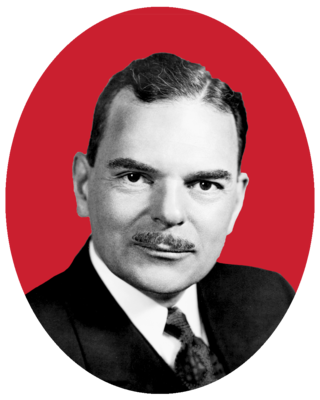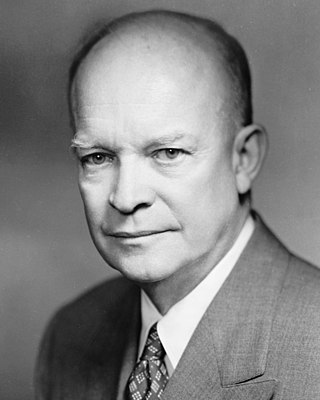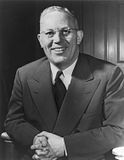
The 1944 United States presidential election was the 40th quadrennial presidential election. It was held on Tuesday, November 7, 1944. The election took place during World War II, which ended the following year. Incumbent Democratic President Franklin D. Roosevelt defeated Republican Thomas E. Dewey to win an unprecedented fourth term. It was also the fifth presidential election in which both major party candidates were registered in the same home state; the others have been in 1860, 1904, 1920, 1940, and 2016.

The 1948 United States presidential election was the 41st quadrennial presidential election. It was held on Tuesday, November 2, 1948. In one of the greatest election upsets in American history, incumbent President Harry S. Truman, the Democratic nominee, defeated heavily-favored Republican Governor of New York Thomas E. Dewey and other third-party candidates, becoming the third president to succeed to the presidency upon his predecessor’s death and be elected to a full term.

The 1952 United States presidential election was the 42nd quadrennial presidential election and was held on Tuesday, November 4, 1952. Republican Dwight D. Eisenhower won a landslide victory over Democrat Adlai Stevenson II, becoming the first Republican president in 20 years.

The 1952 Republican National Convention was held at the International Amphitheatre in Chicago, Illinois from July 7 to 11, 1952, and nominated the popular general and war hero Dwight D. Eisenhower of New York, nicknamed "Ike," for president and the anti-communist crusading Senator from California, Richard M. Nixon, for vice president.

The 1948 Republican National Convention was held at the Municipal Auditorium, in Philadelphia, Pennsylvania, from June 21 to 25, 1948.
The 1944 Republican National Convention was held in Chicago, Illinois, from June 26 to 28, 1944. It nominated Governor Thomas E. Dewey of New York for president and Governor John Bricker of Ohio for vice president.

From March 11 to June 3, 1952, delegates were elected to the 1952 Republican National Convention.

From March 9 to June 1, 1948, voters of the Republican Party elected delegates to the 1948 Republican National Convention, in part to choose the party nominee for president in the 1948 United States presidential election.

The 1948 United States elections were held on November 2, 1948. The election took place during the beginning stages of the Cold War. Democratic incumbent President Harry S. Truman was elected to a full term, defeating Republican nominee New York Governor Thomas E. Dewey and two erstwhile Democrats. The Republicans, who had just won both the House and the Senate two years earlier, ceded control of both chambers of Congress to the Democrats. Puerto Rico also elected Luis Muñoz Marín of the Popular Democratic Party as its first democratically elected governor.

Electoral history of Robert A. Taft, United States Senator from Ohio (1939–1953), United States Senate Majority Leader (1953) and a candidate for the 1940, 1948 and 1952 Republican presidential nominations.

The 1948 United States presidential election in New Jersey took place on November 2, 1948. All contemporary 48 states were part of the 1948 United States presidential election. Voters chose 16 electors to the Electoral College, which selected the president and vice president.

The 1948 United States presidential election in New Hampshire took place on November 2, 1948, as part of the 1948 United States presidential election, which was held throughout all contemporary 48 states. Voters chose four representatives, or electors to the Electoral College, who voted for president and vice president.

This article lists those who were potential candidates for the Republican nomination for Vice President of the United States in the 1976 election. At the 1976 Republican National Convention, incumbent President Gerald Ford narrowly won the presidential nomination over former California Governor Ronald Reagan. Ford had decided not to choose Vice President Nelson Rockefeller as his running mate, due to Rockefeller's unpopularity with the right wing of the Republican Party. He instead chose Senator Bob Dole of Kansas. Dole was acceptable to the conservative wing of the party, and Ford hoped that Dole would help the ticket win the western states and the agricultural vote. The Ford–Dole ticket lost the general election to the Carter–Mondale ticket. Though he would not win the presidential nomination, Reagan announced before the convention that he would pick Senator Richard Schweiker of Pennsylvania as his running mate. Dole went on to become Senate Republican leader, and the Republican presidential nominee in 1996, losing the general election to incumbent President Bill Clinton.

This article lists those who were potential candidates for the Republican nomination for Vice President of the United States in the 1960 election. After winning the Republican presidential nomination at the 1960 Republican National Convention, Vice President Richard Nixon needed to choose a running mate. President Dwight D. Eisenhower strongly supported UN Ambassador Henry Cabot Lodge Jr. Though Lodge lacked charisma as a campaigner, his foreign policy experience and stature as ambassador made him an appealing candidate. However, Lodge was unpopular with the Republican right, who did not want a Northeastern moderate on the ticket. Nixon also strongly considered conservative Minnesota Representative Walter Judd and moderate Kentucky Senator Thruston Morton. After a closed session with Republican Party leaders, Nixon announced his choice of Lodge. The Republican convention ratified Nixon's choice of Lodge. The Nixon–Lodge ticket lost the 1960 election to the Democratic ticket of Kennedy–Johnson.

This article lists those who were potential candidates for the Democratic nomination for Vice President of the United States in the 1952 election. After winning the presidential nomination on the third ballot of the 1952 Democratic National Convention, Illinois Governor Adlai Stevenson consulted with Democratic Party leaders such as President Harry S. Truman and Speaker Sam Rayburn. Stevenson chose Alabama Senator John Sparkman, a Southern centrist, as his running mate. Sparkman won the vice presidential nomination on the first ballot as no serious rival tried to displace Stevenson's choice. However, many Northerners were not enthused with the choice of Sparkman due to Sparkman's stance on civil rights. During the 1952 convention, Sparkman, who had supported Senator Richard Russell for president, played a part in watering down the party's platform on civil rights. New York Representative Adam Clayton Powell Jr. and others walked out of the convention after the choice of Sparkman was announced. The Democratic ticket lost the 1952 election to the Republican ticket of Dwight D. Eisenhower and Richard Nixon.

This article lists those who were potential candidates for the Democratic nomination for Vice President of the United States in the 1948 election. At the 1948 Democratic National Convention, President Harry S. Truman won nomination for a full term. Truman had become president upon the death of his predecessor and 1944 running mate, Franklin D. Roosevelt. As the 25th Amendment had not yet been passed, there was no method for filling a vice presidential vacancy, and Truman served without a vice president during his first term. Truman's nomination faced significant opposition from the South, as did the party's platform on civil rights. Though Truman attempted to convince Supreme Court Justice William O. Douglas to join the ticket, Douglas declined. Truman instead selected Senate Minority Leader Alben W. Barkley, the preferred choice of many Democratic delegates, and a border state Senator who could appeal to both the Northern and Southern wings of the party. The Truman–Barkley ticket won the 1948 election, defeating the Republican (Dewey–Warren), Progressive (Wallace–Taylor), and Dixiecrat (Thurmond–Wright) tickets.

This article lists those who were potential candidates for the Republican nomination for Vice President of the United States in the 1952 election. After defeating Ohio Senator Robert A. Taft for the Republican presidential nomination at the 1952 Republican National Convention, General Dwight D. Eisenhower needed to choose a running mate. Taft recommended Illinois Senator Everett Dirksen, but Eisenhower rejected the suggestion. Eisenhower and his advisers put together a list of prominent Republicans who were acceptable to both the conservative Taft and liberal Dewey wings of the party, anti-Communist, talented at campaigning, relatively young, and who contributed to Eisenhower's nomination victory. After conferring with Republican Party leaders, Eisenhower decided to ask California Senator Richard Nixon to be his running mate; Nixon accepted the offer. Nixon had carefully campaigned for the post of vice president since meeting Eisenhower in 1951, and Nixon helped deliver the California delegation to Eisenhower in the presidential ballot. The Republican convention ratified Eisenhower's choice of Nixon. Months after the convention, Eisenhower considered asking Nixon to step down as running mate due to controversy surrounding campaign expenses, but Nixon rallied public opinion with his Checkers speech and remained on the ticket. The Eisenhower–Nixon ticket won the 1952 election, as well as the 1956 election, defeating the Stevenson–Sparkman and Stevenson–Kefauver tickets, respectively.

This article lists those who were potential candidates for the Republican nomination for Vice President of the United States in the 1944 election. At the start of the 1944 Republican National Convention, New York Governor Thomas Dewey seemed like the likely presidential nominee, but his nomination was not assured due to strong support for Ohio Governor John W. Bricker and former Minnesota Governor Harold Stassen. Though Dewey wanted California Governor Earl Warren as his running mate, Warren was convinced that Franklin D. Roosevelt would win re-election, and refused to be anyone's running mate. Some Republicans wanted to ask Democratic Senator Harry Byrd of Virginia to be the Republican running mate in order to pursue the Southern vote, but this possibility was not seriously pursued. Dewey and his advisers instead worked out a deal in which Bricker's delegates voted for Dewey in the presidential ballot, and Dewey in return chose Bricker as his running mate. The Dewey–Bricker ticket, which balanced the moderate Northeastern and conservative Midwestern wings of the party, was ratified by the Republican convention. The ticket lost the 1944 presidential election to the Roosevelt–Truman ticket.

The 1948 United States presidential election in Rhode Island took place on November 2, 1948, as part of the 1948 United States presidential election. State voters chose four electors to the Electoral College, which selected the president and vice president.

















